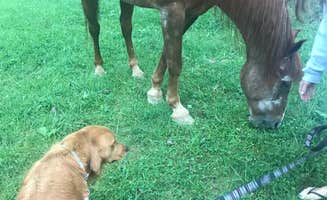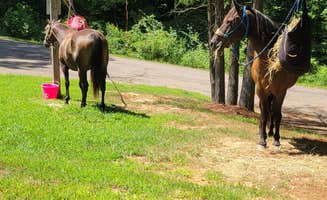Equestrian campgrounds near Geneva, Ohio sit within the foothills of the Appalachian region, where elevation changes create varied terrain ideal for trail riding. Most horse-friendly facilities in the area operate from April through October, though some remain open year-round with limited winter services. The camping areas connect directly to bridle trail networks throughout Wayne National Forest and surrounding state lands.
What to do
Trail riding at Zaleski State Forest: Backpackers and equestrians share this extensive network of trails. The forest features "several loop sections so you can easily plan various trips accordingly" with "great deal of interesting rock formations to check out as well as a few good overlook areas," according to James W. at Zaleski State Forest.
Explore historical sites: The region contains numerous historic iron furnaces and abandoned rail infrastructure. At Lake Hope State Park, "Hope furnace is just outside the campground and next to the first 'put-in' for the lake. As history buffs will know that Ohio was one of the nation's leading iron producers back in the day," notes Dave V., who also recommends visiting "the haunted Moonville Tunnel nearby and worth the short drive and hike."
Water recreation options: Several campgrounds offer lake access with various water activities. At Burr Oak State Park Campground, "campers can rent pontoons or enjoy a day kayaking the lake, or swimming on the beach," explains Larissa C. The lake can get foggy at night, as Robert R. warns: "watch out for the FOG on the lake at night! It gets so bad you can't see past the end of your boat!"
What campers like
Secluded camping spots: Many equestrian campgrounds offer privacy not found at standard campgrounds. At Lake Hope State Park Campground, Dave V. notes: "Each time I have stayed at Lake Hope State Park, I have marveled at why there are only a few stray campers in a state park of 190 sites... Whatever the reason, you rarely, if ever, will have to contend with neighbors."
Direct trail access: The ability to ride from campsites without trailering horses is highly valued. At Pine Creek Cabins & Camping Resort, CampgroundKaren observed that cabins were "very clean, with thoughtful amenities" and noted the "bridle trail access right from campground," along with the fact that some cabins include horse stalls.
Varied terrain options: Horse trails range from beginner-friendly flat paths to more challenging routes with elevation changes. At Dorr-Run Red Oak Trailhead, Taylor P. noted there are "plenty of pull-off areas on the road leading up to this trailhead" and "several fire rings" for camping, though it can get "super busy" on weekends.
What you should know
Hunting season awareness: During hunting seasons, campgrounds experience increased traffic and activity. Marshall P. noted at Palmerosa Horse & Hike Campground that "the new owners of the Palmerosa Campground have put a lot of time and money into this campground! Almost everything has been tore down and rebuilt," including "28 new covered stalls" that are "amazing and plenty if room for larger horses."
Facility standards vary: Some horse camps have basic amenities while others offer more comprehensive facilities. At Old Stone Church Campground, Tammy F. explains the campsite fee is "$15 on the honor system. If you have a National Park's Golden Age or Access pass, they honor a 50 percent discount." She found a "surprisingly clean" pit toilet but noted "there may be more services during the height of the season."
Weather considerations: Trails can become muddy after rain, affecting riding conditions. Doug H. at Dorr-Run found that "OHV trails closed for winter. Hiking allowed year-round. Most campsites inaccessible during off-season. Pit toilet closed for winter."
Tips for camping with families
Opt for campgrounds with diverse activities: Some horse camps offer additional recreation options for non-riders. At Hocking Hills State Park Campground, Bryn S. notes: "Out-of-staters are unaware of the incredible beauty that Hocking Hills brings to Ohio. I can return time and time again and still be in awe of the waterfalls, cliffs and coves."
Check bathroom accessibility: Family camping requires convenient facilities. Kate W. reports from Zaleski: "The sites are mostly far apart from one another and the area is fairly dense woods leaving you feeling a peaceful solitude. There are ample outhouses that are reasonably clean and well-stocked in toilet paper."
Consider walk-in distance: Some camping areas require hiking gear from parking areas. Amanda P. warns: "Make sure to pay attention to 'walk-in' sites. It's more like 'hike a half mile with your gear' sites! All in all we had a blast and a good laugh about our trek with all our stuff!"
Tips from RVers
Leveling challenges at horse camps: Many equestrian sites are on uneven terrain. Daniel at Lake Hope reported: "Camp sites are very small and very unlevel, had to raise back of camper and put front about a 1/4" off ground to get close to level. Site around is sloped in all directions."
Plan for limited hookups: Most horse camps provide basic services only. At Dillon State Park Campground, Brian B. notes it's "located about 10 miles west of Zanesville, OH in a heavily forested area. There is no road noise from the local route 146 used to access the campground. There is reasonable space between the sites to allow for some privacy and to allow you to spread out."
Know your rig size limits: Not all horse camps accommodate larger RVs. At Alum Creek State Park Campground, Sandy O. appreciates the "space and privacy...the two things that bring me back to this campground year after year. We have never had a 'bad' campsite at the Alum Creek State Park Campground. Each camping space is separated by trees and brush."




